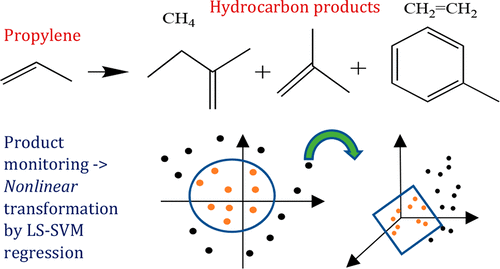当前位置:
X-MOL 学术
›
Ind. Eng. Chem. Res.
›
论文详情
Our official English website, www.x-mol.net, welcomes your
feedback! (Note: you will need to create a separate account there.)
Least Squares-Support Vector Regression for Determining Product Concentrations in Acid-Catalyzed Propylene Oligomerization
Industrial & Engineering Chemistry Research ( IF 3.8 ) Pub Date : 2018-09-19 , DOI: 10.1021/acs.iecr.8b02539 Kaushik Sivaramakrishnan 1 , Jinjun Nie 1 , Arno de Klerk 1 , Vinay Prasad 1
Industrial & Engineering Chemistry Research ( IF 3.8 ) Pub Date : 2018-09-19 , DOI: 10.1021/acs.iecr.8b02539 Kaushik Sivaramakrishnan 1 , Jinjun Nie 1 , Arno de Klerk 1 , Vinay Prasad 1
Affiliation

|
This work is concerned with the development of multivariate calibration models to establish spectrum-composition relationships for the hydrocarbon products in the H-ZSM-5-catalyzed oligomerization of propylene. Regression models based on two multivariate methods were investigated in this work: least-squares-support vector machines (LS-SVM) and partial least-squares (PLS) regression. The performance of two nonlinear kernels, radial basis function (RBF) and polynomial, is compared with PLS as well as its variant, interval-PLS regression (i-PLSR). For comparison with i-PLSR, the Fourier transform infrared (FTIR) spectra of the products served as inputs and the respective C1–C10 concentrations, obtained from gas chromatography (GC), were the outputs. The sensitivity of the product distribution to inlet operating conditions was also evaluated through the calibration methods. Spectral clusters having distinct chemical character were identified using principal component analysis (PCA) and hierarchical clustering analysis (HCA) and also used as inputs to the different regression techniques to compare with the full spectrum models. It was found that the best performing spectral regions from i-PLSR had chemical relevance and agreed with findings from HCA, improving the predictive capabilities significantly. The decreasing order of performance of the chemometric methods evaluated was: LS-SVM-RBF > LS-SVM-Polynomial > i-PLS > PLS. The prediction accuracy of RBF kernel-based LS-SVM regression technique was the highest, indicating its suitability for effective online monitoring of moderately complex processes like acid-catalyzed propylene oligomerization.
中文翻译:

最小二乘支持向量回归法测定酸催化丙烯低聚反应中的产物浓度
这项工作与建立多元校正模型有关,以建立H-ZSM-5催化丙烯低聚反应中烃类产物的光谱-成分关系。在这项工作中研究了基于两种多元方法的回归模型:最小二乘支持向量机(LS-SVM)和偏最小二乘(PLS)回归。将径向基函数(RBF)和多项式这两个非线性核的性能与PLS及其变体,区间PLS回归(i -PLSR)进行了比较。为了与i -PLSR进行比较,将产品的傅立叶变换红外(FTIR)光谱用作输入,并分别使用C 1 –C 10从气相色谱(GC)获得的浓度为输出。还通过校准方法评估了产品分布对入口操作条件的敏感性。使用主成分分析(PCA)和层次聚类分析(HCA)可以识别具有不同化学特征的光谱簇,还可以将其用作不同回归技术的输入,以与全光谱模型进行比较。发现i -PLSR的最佳光谱区域具有化学相关性,并且与HCA的发现一致,从而大大提高了预测能力。所评估的化学计量学方法的性能递减顺序为:LS-SVM-RBF> LS-SVM-多项式> i-PLS> PLS。基于RBF核的LS-SVM回归技术的预测准确性最高,表明它适用于有效在线监测酸催化的丙烯低聚等中等复杂过程。
更新日期:2018-09-19
中文翻译:

最小二乘支持向量回归法测定酸催化丙烯低聚反应中的产物浓度
这项工作与建立多元校正模型有关,以建立H-ZSM-5催化丙烯低聚反应中烃类产物的光谱-成分关系。在这项工作中研究了基于两种多元方法的回归模型:最小二乘支持向量机(LS-SVM)和偏最小二乘(PLS)回归。将径向基函数(RBF)和多项式这两个非线性核的性能与PLS及其变体,区间PLS回归(i -PLSR)进行了比较。为了与i -PLSR进行比较,将产品的傅立叶变换红外(FTIR)光谱用作输入,并分别使用C 1 –C 10从气相色谱(GC)获得的浓度为输出。还通过校准方法评估了产品分布对入口操作条件的敏感性。使用主成分分析(PCA)和层次聚类分析(HCA)可以识别具有不同化学特征的光谱簇,还可以将其用作不同回归技术的输入,以与全光谱模型进行比较。发现i -PLSR的最佳光谱区域具有化学相关性,并且与HCA的发现一致,从而大大提高了预测能力。所评估的化学计量学方法的性能递减顺序为:LS-SVM-RBF> LS-SVM-多项式> i-PLS> PLS。基于RBF核的LS-SVM回归技术的预测准确性最高,表明它适用于有效在线监测酸催化的丙烯低聚等中等复杂过程。











































 京公网安备 11010802027423号
京公网安备 11010802027423号